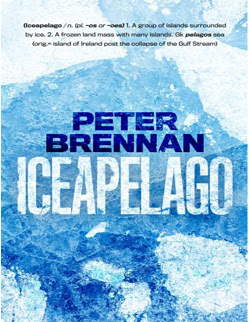
This was an interesting premise. I won't regurgitate the plot myself, the publicists do that job well (see below). I was sent this book for review, all the way from Ireland!
I learned a lot from the book, and recalled things I have forgotten, such as icebergs calving, for example. I can tell the author, Dr. Peter Brennan, knows his topic intimately. He has written several non-fiction books from his perspective in Ireland about climate change.
This book wove a lot of information into the plot.
He has a wide range of characters, and he uses the learned to educate the few, including the reader. Sometimes, if an author is try to teach us something through the medium of a novel, I feel they are lecturing. This wasn't the case.
There was lots of riveting action, although most of it did not end well. A conflagration of Climate Change: ice melting, earthquakes, and the like, led to a deep, dark novel.
The beauty of reading a novel is creating the imagery in your mind. This author was very descriptive, and he knows his stuff. I could picture the glaciers, icebergs, and the volcanoes, as well as the human structures he describes, i.e., the Summit Station (see below). I think it might make a great movie, as well!
The action takes place in three disparate locations: atop the Greenland Ice Sheet, on the volcanic island of La Palma in the Canary Islands, and on the seabed off the Irish Continental Shelf. I would have loved a map. I truly have not heard about La Palma, for example. I finished the book on the back deck, with my brand new, non-cataract eyes. It was delightful to be able to read comfortably again. I read several chapters on the back deck to get to the end.
 |
| La Palma, in the Canary Islands |
Brennan's descriptions were lavish. The author has visited all these places. His website has a gallery, which was really helpful.
 |
| Summit Station: The scientists discuss their options atop the Greenland Ice Sheet. |
 |
| Ililussat: The graveyard of icebergs. |
 |
| Tasiliilaq; The Sama leaves Tasiilaq |
Dr. Brennan is writing a sequel, Aftermath, which I will look forward to, as this book was gripping. I hope he includes a map. A list of acronyms would be helpful, as well, although he makes a point of writing them out in most instances.
There were a few errors, which are disconcerting to a reader. I read that the pilot cut of his engines, rather than off. Also, there was a missing word. One paragraph began: leant sideways to kiss his wife.
There is a tendency to use gender exclusive language, which, in 2020, isn't acceptable to this feminist, i.e., 'mankind,' rather humankind or humans.
One of the characters makes a joke using the word 'Eskimo,' which isn't used anymore in Canada. Instead, they are Inuit. He does include strong female scientists, which was comforting to read. We've worked for years to encourage women in STEM. My daughter has her M.Sc., and there are many STEM women about.
Iceapelago: Epic “Climate Change Thriller” Plunges Ireland into Arctic Tundra. It’s Fiction, For Now…
Dr. Peter Brennan’s ‘Iceapelago’ is the product of a lifetime’s interest in climate change, and research trips to La Palma and Greenland, as the author embroils readers in three interconnected storylines, each a stark and bold warning. Tsunamis and the collapse of the Gulfstream have transformed Ireland into a flooded, ice-cold, and barren landscape; perfect for the arctic foxes that now call it home. A story that fuses humanity, the sciences, the environment and wildlife; ‘Iceapelago’ truly becomes a new word for what may become a new world…
Iceapelago is available now. For more information, visit the website.














































